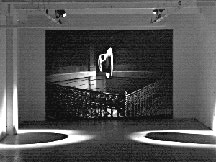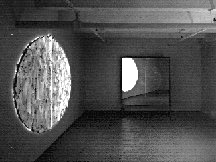- MAIN INDEX | ARTIST INDEX
| September 15 - October 13, 1979 John Massey Curated by David MacWilliam | |
 John Massey, installation view, 1979, Photo Robert Keziere. 18K |  John Massey, installation view, 1979, Photo Robert Keziere. 18K |
|
At The Drop Of A Hat
a descriptive analysis by Paul Collins and G Robinson John Massey has erected a wall length-wise down the middle of the gallery at Mercer Union, dividing the space into two rooms that make up A Directed View (the first two rooms) . The room that one first encounters upon entering the gallery contains a large, over-sized, felt fedora. Though not Oldenburgian in dimension, at about size 16, the hat is large and well made enough to be impressive. It is suspended in mid air, by wires, in front of a rear projected photograph. The blue tinted photograph depicts a square enclosure, one corner of which is in the foreground. The intersecting sides of the corner are defined by a large, ornate, wrought iron railing. The other two sides are fluted stone walls with squared doric columns and indistinct friezes. One assumes that the railing overlooks a staircase leading to a lower level. This same photograph appears in an earlier work by Massey, a large poster print that leaves out the hat and in its stead contains the statement "The Ornate Railing of Partial Appeasement". Obviously this image, of this particular railing holds some special meaning for the artist, and its various augmentative elements are seemingly interchangeable. From viewing/reading the poster print one assumes a literary meaning, the nature of which can only be guessed. In a further usage of the image, one would hope for a further development and/or clarification of the idea or meaning. In this case, the seemingly surrealistic juxtaposition of the hat with the interior shot, tends to obscure any meaning further. (Unless, of course, Massey is using the image of a tipped hat to symbolise appeasement, in which case the piece relates beautifully to his previous work, and we are left only to decipher his original ambiguity. Someone suggested that the hat might belong to the lord of this manor that features the stairwell. From this perhaps we can discern some Marxist meaning. Or perhaps this is the hat worn by Joseph Beuys, from which we can presume some more formal meaning). In attempting to discern meaning from the installation one makes allusions to works such as the paintings of Magritte and Hans Richter's film Ghosts Before Breakfast (Unlike these historical precedents, Massey's placement of the hat is not in its traditional position, i.e., horizontal, ready for the head or suggesting an invisible wearer. But rather it is vertical, suspended, caught in the act of falling. The hat, suspended a few feet in front of the rear projection screen, is illuminated by two spot lights placed opposite to each other, at ceiling level. These lights illuminate the crown and the inside of the hat, casting two ovular shadows onto the floor at opposite sides of the room. This lighting of the hat exaggerates the separation between photograph and hat, however, from seeing Massey's poster announcing the show, the illusion created is of the hat suspended beyond the railing, over the stairwell, hovering or ready to fall. In the gallery because one is walking around the hat, investigating its construction, walking up to the photograph to inspect it for missed bits of information, or standing in the doorway leading from this room to the second room, doing a comparative study of the two rooms, one is unlikely to make the connection that the two images can be fused into one. If the poster is any clue as to how the piece should be viewed, it is through one eye (to break down the three dimensional space) and from a specific distance (to achieve the desired placement of the hat). If this is the proper way of viewing this piece, then its effectiveness as a room is diminished as it becomes more akin to a traditional wall piece. The fact that one can walk all the way around the hat, thereby intercepting the light beams casting shadows onto the floor, keeps this construction within the realm of sculpture; or at least within the realm of 'room'. Massey's use of light provides the viewer with a connection between the first and second room. In the first room there is a contrast between the cold, square materiality of the architecture depicted in the photograph and the soft form of the hat with the even softer forms of the ovular shadows. In the second room there is an opposite 'movement' from the ephemeral to the material. However, this 'movement' in the second room is of a more linear nature. You enter at one end of the room: in the corner a spot light projects a single beam of light across the room: in the corner a spot light projects a single beam of light across the room where it is intercepted by a large, square mirror angled in such a way as to cast the reflected light in an oval shape onto the wall, defining the perimeters of an oval plaster and lath wall construction which hangs above the floor, flush against the wall. The projected light and the plaster mass so accurately define each others' perimeters that one wonders which came first, the light or the egg-shaped mass? The spectral effect created at the outer extremities of this light on the wall provide the only real colour in the room. The square mirror is actually made up of two vertically rectangular mirrors butted up against each other. The plaster is illuminated evenly over the surface except where the light is reflected off the seam of the abutment casting a lighter line onto the plaster oval, bisecting it in half. The surface of the plaster construction is alive with the sweeping strokes of the trowel, the illumination off the mirror accentuates the surface, making it a field of light and shadow. The reflected image in the mirror is severely flattened, all but obscuring the marks left by the trowel, and enabling us to see that Massey has actually used two tones of plaster in the oval shape, with the lighter plaster at the top, The effect is of a floating snow-capped mountain. The linear movement is completed; having gone from pure light to the rough hewn materiality of the oval construction to the transient nature of its mirror reflection. The specific nature of this room enables one to interact with the piece. By crossing in front of the beam of light, one casts a shadow on the plaster and its reflection, and therefore, is 'drawing' on the shape. The placement of the spot light directly at the entrance of the room, makes this eclipsing of the ovoid inevitable. That is, Massey directs us to manipulate this piece, giving a double meaning to the title A Directed View. . . He directs the light (our eye) from the source to the mirror, to the plaster construction, back into the mirror. And he directs our presence into a more active relationship with the light and therefore the whole linear progression of our vision. The more static nature of the first room is exaggerated by the dynamism inherent in the second room. Once the interception of the beam V has been completed, by standing next to the plaster form and staring straight into the mirror a circle of the actual surface of the glass is illuminated by the spot light. Sweeping marks made by the cleaning of the glass are made apparent and, whether it was the intention of the artist or not, these marks are remarkably similar to the markings made by the trowel in spreading the plaster over the lathe in the ovoid shape. In my opinion, the second room offers more entrances into the whole piece than did the first. Massey utilities the second space in a way enabling one to more fully interact with the space and the objects contained by it. He uses a less personal symbolism which enables the viewer to more readily and confidently attempt to understand the work. If, as it appears, that Massey has constructed a cosmographic model dealing with certain celestial and dimensional relationships, then it is by its very nature more universal and less immediately esoteric than the first room. Assuming that the first room was conceived and executed before the second, one hopes that a progression has been established, and that Massey's future rooms (as hinted at in the title 'the first two rooms') will continue in this movement towards clarity. If the converse is true, the viewer of Massey's work can expect a series of technically competent but conceptually inaccessible constructions. Paul Collins, Toronto artist, is the proprietor of Permanent Press, Gillian Robinson is a Toronto freelance writer.
| |